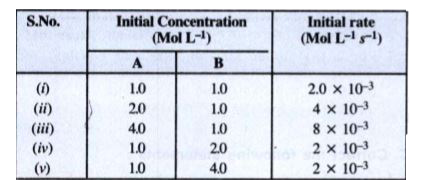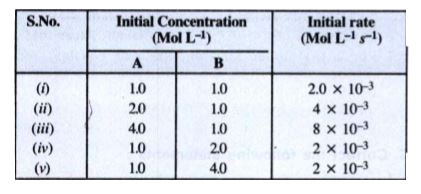Consider the reaction,
aA+bB→cD.
if 4M of A are allowed to react with 2 Mof B and concentration of A after 4 seconds is 3 M, calculate the rate of reaction. Mention it in terms of A as well as D.
To solve the problem, we need to calculate the rate of reaction based on the given concentrations of reactants A and B, and the change in concentration of A over time.
1. Identify Initial and Final Concentrations of A:
- Initial concentration of A, (A)₀ = 4 M
- Final concentration of A after 4 seconds, (A)ₜ = 3 M
2. Calculate the Change in Concentration of A:
- Change in concentration of A, Δ(A) = (A)ₜ - (A)₀
- Δ(A) = 3 M - 4 M = -1 M
3. Determine the Time Interval:
- Time interval, Δt = 4 seconds
4. Calculate the Rate of Reaction in Terms of A:
- The rate of reaction (in terms of A) is given by the formula:
Rate=−1ΔtΔ(A)
- Substituting the values:
Rate=−14×(−1)=14 M/s
5. Express the Rate of Reaction in Terms of D:
- The stoichiometry of the reaction is given as aA+bB→cD.
- From the reaction, the rate of formation of D can be expressed as:
Rate=1cd(D)dt
- Assuming the stoichiometric coefficient of D is 1 (c = 1), we can write:
Rate=d(D)dt
- Since the rate of disappearance of A is equal to the rate of appearance of D (based on stoichiometry), we have:
d(D)dt=14 M/s
Final Answers:
- Rate of reaction in terms of A: 14 M/s
- Rate of reaction in terms of D: 14 M/s
- Initial concentration of A, (A)₀ = 4 M
- Final concentration of A after 4 seconds, (A)ₜ = 3 M
- Change in concentration of A, Δ(A) = (A)ₜ - (A)₀
- Δ(A) = 3 M - 4 M = -1 M
- Time interval, Δt = 4 seconds
- The rate of reaction (in terms of A) is given by the formula:
Rate=−1ΔtΔ(A)
- Substituting the values:
Rate=−14×(−1)=14 M/s
- The stoichiometry of the reaction is given as aA+bB→cD.
- From the reaction, the rate of formation of D can be expressed as:
Rate=1cd(D)dt
- Assuming the stoichiometric coefficient of D is 1 (c = 1), we can write:
Rate=d(D)dt
- Since the rate of disappearance of A is equal to the rate of appearance of D (based on stoichiometry), we have:
d(D)dt=14 M/s
- Rate of reaction in terms of A: 14 M/s
- Rate of reaction in terms of D: 14 M/s
Topper's Solved these Questions
- CHEMICAL KINETICSBOOK - ICSECHAPTER - CHEMICAL KINETICSEXERCISE - PROBLEM
165 Videos
- CHEMICAL KINETICSBOOK - ICSECHAPTER - CHEMICAL KINETICSEXERCISE - INTEXT QUESRTIONS
81 Videos
- BIOMOLECULESBOOK - ICSECHAPTER - BIOMOLECULESEXERCISE - ISC EXAMINATION QUSTIONS (PART-I)(DESCRIPTIVE QUESTIONS)
21 Videos
- CHEMISTRY IN EVERYDAY LIFEBOOK - ICSECHAPTER - CHEMISTRY IN EVERYDAY LIFEEXERCISE - EXERCISE (PART - II (DESCRIPTIVE QUESTIONS) (LONG ANSWER QUESTIONS))
19 Videos
Similar Questions
Consider the reaction, A+B→C+D.
The initial rate for different initial concentrations of the reactants are given below :

Calculate the rate constant.
View SolutionConsider the reaction, A+B→C+D.
The initial rate for different initial concentrations of the reactants are given below :

Calculate the rate constant.
View SolutionConsider the reaction, A+B→C+D.
The initial rate for different initial concentrations of the reactants are given below :

Calculate the rate constant.
View SolutionConsider the reaction, A+B→C+D.
The initial rate for different initial concentrations of the reactants are given below :

Write the rate law equation.
View SolutionConsider the reaction, A+B→C+D.
The initial rate for different initial concentrations of the reactants are given below :

Write the rate law equation.
View SolutionConsider the reaction, A+B→C+D.
The initial rate for different initial concentrations of the reactants are given below :

Write the rate law equation.
View SolutionConsider the reaction, A+B→C+D.
The initial rate for different initial concentrations of the reactants are given below :

What is the overall order ?
View SolutionConsider the reaction, A+B→C+D.
The initial rate for different initial concentrations of the reactants are given below :

What is the overall order ?
View SolutionConsider the reaction, A+B→C+D.
The initial rate for different initial concentrations of the reactants are given below :

What is the overall order ?
View SolutionFor the reaction 2A + 3B to 4C, rate of appearance of C is equal to
View Solution
